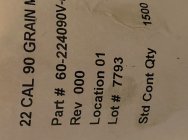There was a time when I’d gladly drop 88 grains of H1000 into a .338 LM case, the same powder that by a smidge works the best for me in a SAUM.
I’m now considering unloading rounds just to recover H1000 for Indiana this July. I never realized so much H1000 got loaded into all the popular handgun and hunting rounds the record new shooters bought up . That scrounging is not like eating leftovers from the refrigerator, but from a hole ripped in warm, week-old Hefty bag.
. That scrounging is not like eating leftovers from the refrigerator, but from a hole ripped in warm, week-old Hefty bag.
Yeah, I’m venting, but brass makers apparently think the RSAUM cartridge is no win proposition, since way before Covid. It’s almost never available despite always being expensive. Norma discontinued it.
Lapua and several others that make regular long action magnums - I think - by passing are basically indicating a belief that the short magnum design and soft “brass” case heads are maybe incompatibly “too efficient” at powder combustion? (Like an old cartoon’s black “TNT” sphere that goes kaboom, with unacceptable short life in their estimation?)
They (Lapua) make a .222 Remington for 37 people and the world’s finest 7.62x39, kind of overkill for that cartridge (AK-47 original) if you ask me, but not a single short magnum in 7 or 30, potentially the highest point netting F-Class open option in the most popular precision discipline.

But maybe the easy-keeping .223 is a bright spot in all this shortage.
Only 25.0 grains of Varget gives moly Berger 90’s all the push that CCI 41 small rifle primers can happily endure. That’s a huge powder savings, considering that rifle powder I saw today was already $50 a pound for new VV, on the way to double old prices, and that retailer does not overcharge.
Powder is on the way to exceeding the cost of the bullet, and by its weight is already multiples higher than match bullets and brass.
I’ve never found .223 brass hard to locate. Good barrel life. But, I have never shot one at 1,000 in a match. I’m wondering if new generation bullets can contend at 1,000, or if they are hopelessly outgunned.
I shot mine at 200 yards where I could see holes easily between mirage and 11 mph wind cycles. I like how predictably the impact traces holds, even if it moves in the wind more than say a 7 magnum.
I’m now considering unloading rounds just to recover H1000 for Indiana this July. I never realized so much H1000 got loaded into all the popular handgun and hunting rounds the record new shooters bought up
Yeah, I’m venting, but brass makers apparently think the RSAUM cartridge is no win proposition, since way before Covid. It’s almost never available despite always being expensive. Norma discontinued it.
Lapua and several others that make regular long action magnums - I think - by passing are basically indicating a belief that the short magnum design and soft “brass” case heads are maybe incompatibly “too efficient” at powder combustion? (Like an old cartoon’s black “TNT” sphere that goes kaboom, with unacceptable short life in their estimation?)
They (Lapua) make a .222 Remington for 37 people and the world’s finest 7.62x39, kind of overkill for that cartridge (AK-47 original) if you ask me, but not a single short magnum in 7 or 30, potentially the highest point netting F-Class open option in the most popular precision discipline.

But maybe the easy-keeping .223 is a bright spot in all this shortage.
Only 25.0 grains of Varget gives moly Berger 90’s all the push that CCI 41 small rifle primers can happily endure. That’s a huge powder savings, considering that rifle powder I saw today was already $50 a pound for new VV, on the way to double old prices, and that retailer does not overcharge.
Powder is on the way to exceeding the cost of the bullet, and by its weight is already multiples higher than match bullets and brass.
I’ve never found .223 brass hard to locate. Good barrel life. But, I have never shot one at 1,000 in a match. I’m wondering if new generation bullets can contend at 1,000, or if they are hopelessly outgunned.
I shot mine at 200 yards where I could see holes easily between mirage and 11 mph wind cycles. I like how predictably the impact traces holds, even if it moves in the wind more than say a 7 magnum.
Attachments
Last edited:














